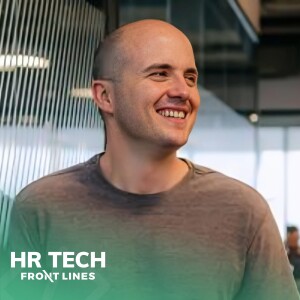Category Visionaries
Welcome to Category Visionaries — the show dedicated to uncovering the go-to-market journeys behind the world’s most exciting B2B tech startups. In each episode, we sit down with a visionary founder who’s not just building a company, but creating or redefining a category. We’ll explore how they identified their market opportunity, crafted their early GTM strategy, scaled traction, and navigated the challenges of building something truly new. If you’re a builder, marketer, or founder, this show is your backstage pass to the GTM blueprints powering category-defining companies. Brought to you by: www.FrontLines.io/FounderLedGrowth — Founder-led Growth as a Service. Launch your own podcast that drives thought leadership, demand, and most importantly, revenue. Don’t Miss: New Podcast Series — How I Hire Senior GTM leaders share the tactical hiring frameworks they use to build winning revenue teams. Hosted by Andy Mowat, who scaled 4 unicorns from $10M to $100M+ ARR and launched Whispered to help executives find their next role. Subscribe here: https://open.spotify.com/show/53yCHlPfLSMFimtv0riPyM
Episodes

4 days ago
4 days ago
Benivo is revolutionizing how enterprises manage their global workforce through HR technology focused on Global Mobility teams. With $30 million in funding, the company has evolved from a failed Airbnb competitor into a thriving B2B platform serving major clients like Google, Microsoft, and Bayer. In this episode of Category Visionaries, we sat down with Nitzan Yudan, CEO and Founder of Benivo, to explore the company's dramatic pivot, their "sell-first, build-later" methodology, and how they've built a lean go-to-market engine that leverages AI and community selling to compete with established players.
Topics Discussed:
Benivo's dramatic pivot from an Airbnb competitor to enterprise HR tech
The "sell-first, build-later" methodology that became company DNA
How they closed Google with "the ugliest page in the history of Internet pages"
Building relationships with enterprise decision-makers through weekly Saturday emails
The costly mistake of trying to create a new category versus meeting buyers where they are
Community selling strategies including LinkedIn Live shows and industry recognition campaigns
Using AI to create efficient go-to-market operations with a team under 10 people
Custom AI tools for sales coaching, RFP responses, and prospect management
GTM Lessons For B2B Founders:
Always sell first, then build: Nitzan's core principle is "sell-first, build-later" - a methodology born from their Google deal where they sold a solution using "the ugliest page in the history of Internet pages" and delivered manually for six months before building the actual product. This approach validates real customer demand and reveals what actually needs to be built versus what founders assume should be built.
Enterprise sales is about selling yourself, not your product: Success with major clients like Google, Microsoft, and Bayer came from building deep personal relationships with decision-makers. Nitzan describes knowing the names of his prospects' children and their preferences - emphasizing that enterprise buyers are investing in people and relationships, not just features. One client relationship was maintained through weekly Saturday evening emails for months before an opportunity materialized.
Match your messaging to how buyers actually buy: Benivo initially tried to create a new category by positioning themselves as a "two-for-one" solution replacing multiple industry layers. This confused buyers who didn't understand how to purchase within their existing procurement processes. When they repositioned to match existing category terminology that buyers recognized, RFP invitations and sales began flowing. The lesson: don't let category creation ambitions override buyer convenience.
Leverage community selling for efficient go-to-market: With only 7-8 people in their entire go-to-market team, Benivo built a powerful community strategy including a LinkedIn Live show hosted by an industry luminary, annual "Top 100" recognition campaigns, and a 200-person "Change Maker Network" that includes prospects, customers, and even lost deals. This approach builds trust and allows enterprise buyers to engage with the company culture before making career-impacting decisions.
Build custom AI tools for competitive advantage: Rather than relying on expensive purpose-built sales tools, Benivo creates custom AI solutions using basic tools like Gemini and Make.com. Their system automatically transcribes sales calls, scores deals using their MEDPIQ methodology, coaches salespeople on next steps, and generates follow-up emails. They've also built AI tools that reduce RFP response time by 70-80% by training models on their best historical responses and client-specific strategy documents.
//
Sponsors:
Front Lines — We help B2B tech companies launch, manage, and grow podcasts that drive demand, awareness, and thought leadership.
www.FrontLines.io
The Global Talent Co. — We help tech startups find, vet, hire, pay, and retain amazing marketing talent that costs 50-70% less than the US & Europe.
www.GlobalTalent.co
//
Don't Miss: New Podcast Series — How I Hire
Senior GTM leaders share the tactical hiring frameworks they use to build winning revenue teams. Hosted by Andy Mowat, who scaled 4 unicorns from $10M to $100M+ ARR and launched Whispered to help executives find their next role.
Subscribe here: https://open.spotify.com/show/53yCHlPfLSMFimtv0riPyM

4 days ago
4 days ago
Thoras AI is pioneering a new category in infrastructure optimization, transforming how engineering teams manage workload efficiency through predictive scaling. Co-founded by twin sisters Nilo and her sibling who worked as reliability engineers for a decade, Thoras AI addresses the reactive nature of traditional infrastructure management. In this episode of Category Visionaries, we sat down with Nilo Rahmani, CEO and Co-Founder of Thoras AI, to learn about their journey from frustrated on-call engineers to building an AI-powered platform that helps reliability teams optimize performance while maintaining application integrity.
Topics Discussed:
The unique dynamic of co-founding a company with your twin sister
Thoras AI's approach to predictive scaling as a wedge into broader infrastructure automation
The company's differentiation from pure finops/cost optimization tools by prioritizing reliability
Building a premium brand identity that stands out in the crowded AI infrastructure space
The evolution from customer discovery to product-market fit through organic outreach
Creating a new category at the intersection of AI and infrastructure optimization
GTM Lessons For B2B Founders:
Stop coding and start talking to customers first: Nilo's biggest breakthrough came when a Bay Area advisor told her to "stop coding and start talking." Instead of building an MVP in isolation, they spent months conducting customer discovery across the country. This approach revealed genuine pain points and validated demand before writing a single line of code. B2B founders should resist the engineer's instinct to build first and instead invest heavily in understanding customer problems through direct conversation.
Validate demand through organic outreach, not friends and family: Thoras AI deliberately avoided selling to their network, choosing instead to validate their solution with complete strangers. Every customer has come through pure organic outreach, providing genuine validation that people truly need the solution rather than doing founders a favor. This approach builds confidence that the product solves real problems and creates a stronger foundation for scaling.
Focus on reliability first, cost savings second: While many competitors position themselves as cost optimization tools, Thoras AI differentiated by prioritizing application reliability and integrity. As Nilo explains, "For the reliability engineer, any attention on us because of an outage is bad attention." This positioning resonates with their target buyers who view uptime as more critical than cost savings, creating a sustainable competitive advantage.
Use premium branding to elevate your industry: Thoras AI intentionally created a consumer-grade brand aesthetic to stand out in the sea of generic B2B tools. Their approach makes reliability professionals "feel like they're elevating not only their role, but their entire team" by using a brand that understands their pain points without marketing fluff. B2B founders should consider how premium branding can differentiate their solution and make customers proud to use it.
Build category definition around customer problems, not technology: Rather than leading with AI capabilities, Thoras AI positions itself around the specific problems reliability engineers face - automation, efficiency, and reducing manual fine-tuning. They're creating a category for "optimization and efficiency" rather than forcing their solution into existing categories like finops or observability. Founders should let customer problems define their category rather than starting with technology capabilities.
//
Sponsors:
Front Lines — We help B2B tech companies launch, manage, and grow podcasts that drive demand, awareness, and thought leadership.
www.FrontLines.io
The Global Talent Co. — We help tech startups find, vet, hire, pay, and retain amazing marketing talent that costs 50-70% less than the US & Europe.
www.GlobalTalent.co
//
Don't Miss: New Podcast Series — How I Hire
Senior GTM leaders share the tactical hiring frameworks they use to build winning revenue teams. Hosted by Andy Mowat, who scaled 4 unicorns from $10M to $100M+ ARR and launched Whispered to help executives find their next role.
Subscribe here: https://open.spotify.com/show/53yCHlPfLSMFimtv0riPyM

5 days ago
5 days ago
Authvia is pioneering conversational commerce, building the infrastructure that enables businesses to accept payments through text messages, WhatsApp, and other messaging platforms. With $30 million in funding raised, the company has connected over 250 payment processors and gateways with 300+ messaging networks globally, creating a seamless payment experience that Chris Brunner believes will become bigger than traditional e-commerce. In this episode, Chris shares his journey from identifying SMS as the most ubiquitous communication channel to building a platform that processes payments with just a four-digit code, all while navigating the complex world of channel partnerships and enterprise sales.
Topics Discussed:
The evolution from app fatigue to messaging-first commerce solutions
Building infrastructure that connects 250+ payment processors with 300+ messaging networks
The challenge of creating a new payment category without established buyers or budgets
Why channel partnerships take years to mature but ultimately provide massive scale
The technical innovation behind tokenized payments over messaging platforms
How regulatory compliance and paper elimination drive enterprise adoption
GTM Lessons For B2B Founders:
Sometimes being early means waiting for the market to catch up: Chris spent years building Authvia before the market was ready, describing how "channels sit" for years before they eventually activate. He emphasizes that conviction in your vision is crucial when you're ahead of market demand. B2B founders building transformative solutions should prepare for extended timelines and focus on building deep partnerships that will pay off when the market matures.
Focus on the financial buyer when there's no established category: Without a clear buyer or budget line item, Chris found success by targeting CFOs and finance teams who could immediately see the cash flow impact of faster payments. He noted, "When you get into the office of the CFO, that group cares... I can get what was going to be paid in 30 days, paid in two hours." B2B founders should identify who benefits most financially from their solution and lead with those metrics.
Build infrastructure that makes partners look good: Rather than trying to sell standalone solutions, Chris focused on creating technology that could be white-labeled by major payment and messaging companies. He explained, "Getting them to sell your stuff that looks and feels like your stuff is next to impossible. Getting them to sell their stuff that looks and feels like them is the home run." B2B founders should consider how their technology can enhance partners' existing offerings rather than compete with them.
Channel partnerships require massive upfront investment: Chris candidly shared that the first five years of channel partnerships showed little return, saying "channels sit, right? And channels do nothing until they eventually do." However, this strategy ultimately provided access to enterprise customers that would have been impossible to reach directly. B2B founders pursuing channel strategies should prepare for long development cycles and ensure they have sufficient runway.
Target the intersection of multiple pain points: Authvia succeeds by solving messaging, payments, and compliance challenges simultaneously. Chris described how customers quickly identify 17 different use cases once they understand the platform. B2B founders should look for solutions that address multiple related problems rather than point solutions, as this creates stronger value propositions and higher switching costs.
//
Sponsors:
Front Lines — We help B2B tech companies launch, manage, and grow podcasts that drive demand, awareness, and thought leadership.
www.FrontLines.io
The Global Talent Co. — We help tech startups find, vet, hire, pay, and retain amazing marketing talent that costs 50-70% less than the US & Europe.
www.GlobalTalent.co
//
Don't Miss: New Podcast Series — How I Hire
Senior GTM leaders share the tactical hiring frameworks they use to build winning revenue teams. Hosted by Andy Mowat, who scaled 4 unicorns from $10M to $100M+ ARR and launched Whispered to help executives find their next role.
Subscribe here: https://open.spotify.com/show/53yCHlPfLSMFimtv0riPyM

Thursday Jul 17, 2025
Thursday Jul 17, 2025
Yard Stick is pioneering the measurement of soil carbon, addressing one of the most invisible yet critical components of climate solutions. With $18 million in funding, the company has developed spectral measurement technology that quantifies soil carbon stocks at field level—unlocking the potential of agricultural systems that store many times more carbon than all plant and animal biomass combined. In this episode, we sat down with Chris Tolles, CEO and Co-Founder of Yard Stick, to explore how they're commercializing breakthrough soil science, navigating a skeptical market, and building trust in the emerging voluntary carbon market.
Topics Discussed:
The critical role of soil carbon in climate solutions versus traditional forest carbon storage
Yard Stick's origin story during COVID-19 and meeting co-founders in a Slack group
How the Department of Energy's Smart Farm program catalyzed soil carbon measurement technology
The connection between agricultural feedstocks, biofuels, and carbon intensity measurements
Building credibility in a scientifically skeptical field through academic publishing
Marketing strategy centered on trust-building rather than traditional tech company approaches
The challenge of creating a new market category for soil carbon measurement services
GTM Lessons For B2B Founders:
Lead with scientific credibility when entering skeptical markets: Chris made the deliberate decision to publish in Geoderma, the world's top soil science journal, despite the pain and slowness of academic publishing. He explains, "Because we're operating in an industry with so much suspicion around measurement and we're trying to make a claim that we're replacing an alternative existing mature measurement technology, I just didn't see a world in which I could sleep at night without the rigor that scientific publishing represents." B2B founders entering fields with established scientific communities should prioritize credibility over speed, especially when challenging existing measurement standards.
Be radically transparent about limitations to build trust: Rather than overselling capabilities, Yard Stick proactively discloses their technology's current limitations. Chris notes, "I think we are way above average, candid about the opportunity and the limitations of our technology with our customers... just like put your liabilities on the table. Then when a customer does say yes, despite those risks, you're all on the same page about what to expect." This approach is particularly powerful in technical fields where customers have sophisticated evaluation capabilities.
Participate authentically in existing industry establishments: Instead of positioning as disruptors, Yard Stick actively participates in traditional soil science conferences and communities. Chris emphasizes, "We go to the Soil Science Society of America's annual meeting, we present there, we have real scientists present there. Being able to hang on their terms is important." B2B founders should consider how to earn credibility within existing professional communities rather than trying to bypass them entirely.
Focus on enabling customer success rather than fighting competitors: Chris takes a "big tent" approach to the climate solutions space, refusing to position against other carbon removal technologies. He explains, "I see a lot of people in the soil ecosystem fight for their teeny little sliver of airtime by talking down to engineered solutions... I think that's a waste of time because we need all of these solutions to be successful in order for the whole ecosystem to grow." This collaborative positioning helps expand the overall market opportunity.
Build your go-to-market strategy around regulatory tailwinds: Yard Stick's timing aligned perfectly with Department of Energy initiatives to reduce carbon intensity in agricultural feedstocks. Chris explains how they capitalized on the DOE's Smart Farm program, which recognized the need for field-level emissions measurement. B2B founders should identify regulatory or policy drivers that create urgency for their solutions and align their market entry accordingly.
//
Sponsors:
Front Lines — We help B2B tech companies launch, manage, and grow podcasts that drive demand, awareness, and thought leadership.
www.FrontLines.io
The Global Talent Co. — We help tech startups find, vet, hire, pay, and retain amazing marketing talent that costs 50-70% less than the US & Europe.
www.GlobalTalent.co
//
Don't Miss: New Podcast Series — How I Hire
Senior GTM leaders share the tactical hiring frameworks they use to build winning revenue teams. Hosted by Andy Mowat, who scaled 4 unicorns from $10M to $100M+ ARR and launched Whispered to help executives find their next role.
Subscribe here: https://open.spotify.com/show/53yCHlPfLSMFimtv0riPyM

Wednesday Jul 16, 2025
Wednesday Jul 16, 2025
Ryp Labs is tackling one of the world's most pressing problems: food waste. Every minute, enough food is wasted globally to feed over 1 million people for a day. If food waste were a country, it would be the third-largest producer of greenhouse gases behind the US and China. In this episode of Category Visionaries, we sat down with Moody Soliman, CEO and Co-founder of Ryp Labs, to learn how his ag-tech startup raised $11 million to develop a revolutionary sticker technology that extends produce shelf life using natural plant compounds.
Topics Discussed:
Ryp Labs' five-year R&D journey to develop natural food preservation technology
The pivot from targeting US/European markets to focusing on Central and South America
How the company leveraged trade shows and competitions for organic marketing
The decision to target distributors and packing houses over direct-to-consumer sales
Scaling challenges and the critical "ship it" moment that validated their technology
Future expansion plans into meat, seafood, dairy, and other food categories
GTM Lessons For B2B Founders:
Follow market pull, not your assumptions: Ryp Labs initially targeted US and European markets, assuming these large, developed markets would be most receptive. However, they found no traction because established players had been "doing the same thing for 50 years" and were resistant to change. When they pivoted to Central and South America, they discovered customers who were highly motivated to export internationally and faced significant cold chain breaks. Moody explained, "We ended up completely shifting our go to market strategy to focus on those areas... they are highly motivated to ship their fruit internationally and to export it to the US or to Europe, because that's where they can get much higher prices." B2B founders should test multiple markets and follow where customers are genuinely desperate for solutions, not where they think the biggest opportunity exists.
Use trade shows and competitions as unfair advantages: Ryp Labs leveraged their "fun and easy to comprehend" technology to win numerous competitions and secure organic media coverage. Moody noted, "We have almost unfair competitive advantage that it's such a fun technology and such an easy technology to comprehend. So we won a lot of those competitions and awards and that gives us free advertisement." For deep-tech startups with limited marketing budgets, industry competitions and trade shows can provide disproportionate exposure and credibility. B2B founders should identify events where their technology's unique aspects can create memorable impressions.
Break the engineer's pencil at the right moment: Despite his team's protests that the product wasn't ready, Moody made the critical decision to ship to a major retailer in 2021. "All right guys, we've taken it as far as we can right now. We just got to put it out there and put it in a customer's hand... we'll learn if it doesn't work." This decision provided the validation and momentum needed to continue development. B2B founders in deep-tech must balance perfectionism with market feedback - sometimes shipping an imperfect product to the right customer is more valuable than months of additional development.
Target the most centralized part of the supply chain: Ryp Labs initially considered selling directly to consumers but recognized the variability in handling would create inconsistent results and blame on their technology. Instead, they focused on distributors and packing houses where "all 1 million pack of strawberries is going from the farm into 2 degrees C" with predictable transportation conditions. This centralized approach allows them to "sell a million stickers to a distributor as opposed to going to 100,000 customers and selling them 10 stickers each." B2B founders should identify the most controlled and centralized points in their target industry's value chain.
Design for regulatory constraints from day one: Coming from the medical device industry, Moody applied a crucial lesson: "You don't develop a technology and then go back and look at the regulatory process... You have to look at that on the front end, really understand what the requirements are going to be from a safety standpoint, and then develop the product to meet those requirements." This approach enabled Ryp Labs to achieve OMRI listing for organic produce and use only food-grade compounds already recognized as safe by the FDA. B2B founders should map regulatory requirements early and design their technology to meet these constraints rather than retrofitting compliance later.
//
Sponsors:
Front Lines — We help B2B tech companies launch, manage, and grow podcasts that drive demand, awareness, and thought leadership.
www.FrontLines.io
The Global Talent Co. — We help tech startups find, vet, hire, pay, and retain amazing marketing talent that costs 50-70% less than the US & Europe.
www.GlobalTalent.co
//
Don't Miss: New Podcast Series — How I Hire
Senior GTM leaders share the tactical hiring frameworks they use to build winning revenue teams. Hosted by Andy Mowat, who scaled 4 unicorns from $10M to $100M+ ARR and launched Whispered to help executives find their next role.
Subscribe here: https://open.spotify.com/show/53yCHlPfLSMFimtv0riPyM

Wednesday Jul 16, 2025
Wednesday Jul 16, 2025
NEURA Robotics is transforming the robotics industry by building cognitive robots powered by physical AI. With €120 million raised and 5,000-10,000 robots already deployed, the company has set an ambitious goal of deploying 5 million robots by 2030. In this episode, I sat down with David Reger, CEO and Founder of NEURA Robotics, to explore how his company is solving the reliability and adoption challenges that have kept robotics a niche market, and his vision for making robots as ubiquitous as smartphones.
Topics Discussed:
NEURA's partnership-driven go-to-market strategy using horizontal and vertical partners
The company's unique physical AI model built specifically for embodied intelligence
Current deployment of household robots starting with elderly care applications
The challenge of raising hardware funding in Europe versus Japan and China
Building cognitive robots that can operate with limited compute and bandwidth
Creating a platform ecosystem where partners can download skills and applications
The regulatory and cultural barriers to robot adoption in different markets
NEURA's recent partnership with SAP and strategy to become Europe's next €100 billion company
GTM Lessons For B2B Founders:
Leverage established channels for reliability-critical products: David built NEURA's entire go-to-market strategy around partnering with established robot companies rather than direct sales. He recognized that for reliability-critical hardware like robots, startups face an inherent trust deficit. "If you're talking about robots, there's all about reliability, it's all about trust because it has to run 24/7... And if you're looking into strength of a startup, that's exactly the point. Like this is something you don't have." B2B founders in hardware or mission-critical software should consider white-label partnerships with established players who already have the service infrastructure and customer trust.
Build horizontal and vertical partnership ecosystems simultaneously: NEURA created a dual partnership model - horizontal partners (robot manufacturers) for broad distribution and vertical partners (domain specialists like welding or household task companies) for specialized applications. This creates a platform effect where "our partners don't have to have the knowledge, but they can simply download, let's say an app or a skill and they can use the robot like in all kinds of different domains." B2B founders should consider how to enable both broad distribution and deep specialization through complementary partnership types.
Target markets where regulatory shifts create urgency: David identified that China's 2030 goal of transforming 5% of working labor to robotics (40 million robots) would force global competition. "The whole world has to, let's say, also wake up in the same time... because if we don't want to end up, let's say as a museum, we have to also contribute." B2B founders should identify geopolitical or regulatory shifts that create market urgency and position their solutions as necessary responses to competitive pressure.
Raise capital in markets that understand your technology: When European and US investors were skeptical of hardware, David found receptive investors in Japan who "believe in robots" and understood the market potential. He eventually had to pivot to China for speed, then later successfully raised €120 million in Europe when the market shifted. B2B founders should be willing to pursue capital in non-obvious geographies where their technology vision is better understood, even if it requires navigating different business cultures.
Focus on physical AI differentiation for embodied products: David emphasized that NEURA's competitive advantage lies in their physical AI model: "I do believe that like our AI model is one of the, let's say it's the best in the world in that space, because simply it's much more efficient and actually built for being physical, while the most other models are not." B2B founders building AI-powered hardware should invest in AI models specifically designed for their physical constraints rather than adapting general-purpose models.
//
Sponsors:
Front Lines — We help B2B tech companies launch, manage, and grow podcasts that drive demand, awareness, and thought leadership.
www.FrontLines.io
The Global Talent Co. — We help tech startups find, vet, hire, pay, and retain amazing marketing talent that costs 50-70% less than the US & Europe.
www.GlobalTalent.co
//
Don't Miss: New Podcast Series — How I Hire
Senior GTM leaders share the tactical hiring frameworks they use to build winning revenue teams. Hosted by Andy Mowat, who scaled 4 unicorns from $10M to $100M+ ARR and launched Whispered to help executives find their next role.
Subscribe here: https://open.spotify.com/show/53yCHlPfLSMFimtv0riPyM

Thursday Jul 10, 2025
Thursday Jul 10, 2025
Revelo has emerged as a critical player in the intersection of talent acquisition and AI development, transforming from a Latin American job board to a comprehensive tech talent platform serving both traditional staffing needs and the booming human data market for LLM training. With $48.7 million raised and a network of 400,000 pre-vetted engineers, Revelo has positioned itself at the forefront of two massive trends: remote work acceleration and the AI revolution. In this episode, Lucas Mendes, Co-founder and CEO of Revelo, shares the company's evolution from a simple recruiting platform to becoming the backbone of tech talent for the age of AI, including their pivot during COVID that led to 6x growth in three years and their recent expansion into human data services for hyperscalers training large language models.
Topics Discussed:
Revelo's origin story and pivot from a Brazilian job board to a nearshoring platform during COVID The dramatic revenue swings during the pandemic - from 80% revenue drop to overwhelming demand The emergence of human data for LLM training as a new business line, growing from 0% to 25% of revenue in 18 months Building specialized platforms for code annotation and LLM training that differ from general-purpose data labeling tools The consulting layer required to serve hyperscalers and why workforce suppliers alone can't compete Revelo's M&A strategy with five acquisitions completed and plans for more transformational deals The long-term vision of becoming the go-to destination for AI implementation talent across all engagement models
GTM Lessons For B2B Founders:
Respond to market signals rather than forcing your vision: Lucas admits that both major pivots - the COVID nearshoring boom and the LLM training opportunity - came from inbound customer demand rather than proactive strategic decisions. He emphasizes being responsive to market signals: "I wish I could claim credit for that, but it was again, us responding to inbound interest from clients." B2B founders should remain agile and let customer demand guide major strategic decisions rather than forcing predetermined visions onto the market.
Build deep expertise to differentiate from commodity suppliers: When serving hyperscalers, Revelo learned that being just a "workforce supplier" wasn't enough. Lucas explains: "There's too many of these companies out there for there to be any meaningful demand for somebody who's just a workforce supplier. You need to have done this before." The company invested heavily in developing consulting capabilities and domain expertise. B2B founders entering competitive markets should identify what specialized knowledge or capabilities will differentiate them from commodity providers.
Leverage your founding team for new market exploration: When building the LLM training business, Lucas deployed his senior leadership team rather than hiring external executives. He explains: "You need to have a founding team for that phase... it's exhausting, it's excruciating, it's stressful, but it is very much an early stage startup." B2B founders should use their core team's entrepreneurial skills when exploring new markets, even if it means senior executives taking on hands-on roles outside their typical functions.
Treat enterprise sales as a repeatable process across teams: Lucas discovered that selling to different teams within the same hyperscaler required starting from scratch each time. His solution: "Build a core corpus of sales collateral, like case studies and materials that they can socialize internally." B2B founders selling to large enterprises should systematize their sales process and create reusable materials that can be adapted for different internal stakeholders, treating each team as a separate sales opportunity.
Use transparency to build trust with sophisticated buyers: When dealing with hyperscalers, Lucas found that honesty about capabilities was crucial: "You have to be really clear about what you can do and what you cannot... Some of these companies are saying, hey, we want to do projects where you'll do human data for code, but also some human data for video. We have to say no to that." B2B founders serving sophisticated enterprise clients should be transparent about their limitations, as attempting to oversell capabilities will ultimately damage relationships with buyers who can easily detect gaps in expertise.
//
Sponsors:
Front Lines — We help B2B tech companies launch, manage, and grow podcasts that drive demand, awareness, and thought leadership.
www.FrontLines.io
The Global Talent Co. — We help tech startups find, vet, hire, pay, and retain amazing marketing talent that costs 50-70% less than the US & Europe.
www.GlobalTalent.co
//
Don't Miss: New Podcast Series — How I Hire
Senior GTM leaders share the tactical hiring frameworks they use to build winning revenue teams. Hosted by Andy Mowat, who scaled 4 unicorns from $10M to $100M+ ARR and launched Whispered to help executives find their next role.
Subscribe here: https://open.spotify.com/show/53yCHlPfLSMFimtv0riPyM

Thursday Jul 10, 2025
Thursday Jul 10, 2025
AgriDigital is transforming the agricultural supply chain through its connected grain management platform that digitizes the traditionally manual, paper-driven grains industry. With $20 million in funding, the company has built a single source of truth platform where buyers and sellers collaborate on contracts and transactions rather than maintaining separate versions. In this episode of Category Visionaries, Emma Weston, CEO and Co-Founder of AgriDigital, shares insights from her eight-year journey building category-defining technology in one of the world's least digitized industries.
Topics Discussed:
The challenge of building in agriculture, the world's least digitized industry
AgriDigital's evolution from paper replacement to connected platform architecture
The strategic decision to focus on hub customers who connect to hundreds of supply chain participants
Navigating the shift from growth-at-all-costs to profitability during market changes
Why traditional marketing doesn't work in agtech and alternative approaches that do
The importance of founder community and authentic customer understanding in agtech
GTM Lessons For B2B Founders:
Target hub customers for network effects: Emma's team identified customers who were connected to 200-500 other participants in the supply chain, creating a hub-and-spoke model. Rather than trying to acquire customers one by one, they focused on central aggregators who naturally brought their network onto the platform. B2B founders in networked industries should map their ecosystem to identify these high-leverage customers who can drive adoption across their entire network.
Resist the temptation to rebrand for funding cycles: AgriDigital deliberately chose not to reposition itself as an AI company, fintech, or climate tech despite having elements of each. Emma explained, "I don't feel any need to try and position us and rebrand us as a climate tech company." This focus allowed them to solve actual customer problems rather than funding problems. B2B founders should resist the urge to chase trending categories and instead build deep expertise in their chosen domain.
Price increases require customer education, not apology: When AgriDigital needed to become profitable, they had direct conversations with customers about sustainability, explaining that there's "only so much that we can expect investors and others to cross subsidize in the development of this technology." Almost all customers understood and accepted necessary price increases. B2B founders should frame pricing conversations around mutual sustainability rather than apologizing for necessary business decisions.
Don't apply other companies' playbooks to unique problems: Emma emphasized that trying to apply lessons from successful companies like Canva was counterproductive: "The only thing we have in common is that they're Australian born as well." Instead, they focused on internal data, hypothesis testing, and small experiments. B2B founders should resist the urge to copy other companies' strategies and instead develop approaches specific to their market and customer base.
Build senior teams for complex problems: During COVID, AgriDigital chose to hire "a smaller, more senior team rather than numerous employees that are more junior." This decision reflected their realization that complex, first-of-their-kind problems require experienced judgment rather than junior execution. B2B founders tackling novel problems should prioritize experience over headcount, especially when building in uncharted territory.
//
Sponsors:
Front Lines — We help B2B tech companies launch, manage, and grow podcasts that drive demand, awareness, and thought leadership.
www.FrontLines.io
The Global Talent Co. — We help tech startups find, vet, hire, pay, and retain amazing marketing talent that costs 50-70% less than the US & Europe.
www.GlobalTalent.co
//
Don't Miss: New Podcast Series — How I Hire
Senior GTM leaders share the tactical hiring frameworks they use to build winning revenue teams. Hosted by Andy Mowat, who scaled 4 unicorns from $10M to $100M+ ARR and launched Whispered to help executives find their next role.
Subscribe here: https://open.spotify.com/show/53yCHlPfLSMFimtv0riPyM

Thursday Jul 03, 2025
Thursday Jul 03, 2025
MacroCycle is pioneering a revolutionary approach to plastic and textile waste, transforming how companies address sustainability challenges while maintaining cost parity with traditional materials. With $7.6 million in funding raised, this upcycling platform has developed breakthrough technology that can process contaminated and colored waste materials that traditional recycling methods cannot handle. In this episode of Category Visionaries, we sat down with Stwart Peña Feliz, Co-founder and CEO of MacroCycle, to explore how his team is creating high-quality recycled materials through an energy-efficient process that could reshape the entire recycling industry.
Topics Discussed:
MacroCycle's proprietary upcycling technology that combines damaged materials into high-quality products
The shift from licensing technology to manufacturing products due to market demands for proven scale
Strategic partnerships with food & beverage and fashion brands seeking recycled content
The regulatory landscape driving mandatory recycled content requirements across Europe and US states
Brand positioning challenges in sustainability versus profitability conversations
The looming supply shortage: why there won't be enough recycled materials for the next decade
Building founder brand recognition through distinctive visual identity and conference presence
GTM Lessons For B2B Founders:
Pivot your business model based on customer feedback: Stwart initially planned to license MacroCycle's technology but discovered customers wouldn't adopt unproven technology at scale. Rather than forcing the original model, they shifted to manufacturing products directly, using a capital-light approach by renting existing petrochemical facilities. This pivot allowed them to prove their technology while generating revenue. B2B founders should remain flexible about their go-to-market approach and let customer readiness dictate strategy rather than forcing an idealized model.
Position around regulatory compliance, not just benefits: While sustainability messaging resonates, Stwart found that regulatory pressure creates the strongest buying motivation. Upcoming EU and US state regulations will mandate minimum recycled content, creating penalties for non-compliance. Companies partnering early with MacroCycle gain supply chain advantages in a market facing a projected decade-long shortage of recycled materials. B2B founders should identify regulatory tailwinds in their industry and position their solution as compliance infrastructure rather than nice-to-have benefits.
Achieve cost parity to eliminate buyer friction: Stwart learned that even environmentally conscious brands won't pay premium prices for sustainable solutions unless legally required. This insight drove MacroCycle's focus on reaching cost parity with traditional materials through their more efficient upcycling process. In commodity markets especially, B2B founders must match incumbent pricing to achieve adoption, using operational advantages rather than premium positioning to win market share.
Underprice to accelerate fundraising momentum: Stwart used a counterintuitive fundraising strategy, deliberately undervaluing MacroCycle to generate multiple competing term sheets. Like pricing a $500K house at $400K to create bidding wars, this approach accelerated their fundraising timeline and ultimately achieved higher valuations through competition. B2B founders confident in their traction should consider strategic underpricing to create investor FOMO and compress fundraising cycles.
Build distinctive founder brand in commodity spaces: Operating in recycling - a crowded commodity market - Stwart recognized the need for radical differentiation. He adopted a signature bright blue jacket for all conferences and presentations, creating instant recognition across continents. This visual branding became so effective that their lawyers suggested trademarking the color for recycling applications. B2B founders in commodity industries should invest heavily in memorable branding to stand out from undifferentiated competitors.
//
Sponsors:
Front Lines — We help B2B tech companies launch, manage, and grow podcasts that drive demand, awareness, and thought leadership.
www.FrontLines.io
The Global Talent Co. — We help tech startups find, vet, hire, pay, and retain amazing marketing talent that costs 50-70% less than the US & Europe.
www.GlobalTalent.co
//
Don't Miss: New Podcast Series — How I Hire
Senior GTM leaders share the tactical hiring frameworks they use to build winning revenue teams. Hosted by Andy Mowat, who scaled 4 unicorns from $10M to $100M+ ARR and launched Whispered to help executives find their next role.
Subscribe here: https://open.spotify.com/show/53yCHlPfLSMFimtv0riPyM

Wednesday Jul 02, 2025
Wednesday Jul 02, 2025
Revv is transforming one of America's most traditional industries with AI-powered technology that helps auto repair shops navigate the complexity of modern vehicles. With over $33 million in funding and explosive growth from 2 to 75+ employees in just 24 months, Revv has found product-market fit in a massive, underserved market. In this episode of Category Visionaries, we sat down with Adi Bathla, CEO and Co-Founder of Revv, to explore how he built an AI platform that's revolutionizing auto repair workflows and compressing sales cycles from 21 days to just 3 days.
Topics Discussed:
Revv's origin story and Adi's path from NASA award winner to auto industry entrepreneur
The regulatory catalyst driving massive industry transformation (government-mandated automatic emergency braking by 2029)
How modern cars evolved from mechanical devices to "computers on wheels" requiring specialized repair knowledge
The challenge of acquiring first customers in a traditionally offline, relationship-driven industry
Revv's approach to integrating with existing shop workflows rather than forcing adoption of new platforms
The intense transition from founder-led sales to scalable go-to-market systems
Building a mathematical rebuild of their sales process that compressed cycles from 21 days to 3 days
Scaling from onboarding 20 shops per month to over 100 shops per month in just 12 months
GTM Lessons For B2B Founders:
Meet customers where they are, not where you want them to be: Adi learned early that success in offline industries requires deep integration with existing workflows rather than forcing behavioral change. "Meeting an offline industry user where they are in their workflow rather than asking them to move towards your way of doing things" became a core thesis. Revv integrates with shops' existing scanning tools and estimatics software, running in the background to provide insights without disrupting established processes. B2B founders entering traditional industries should prioritize workflow integration over user interface innovation.
Leverage regulatory triggers as market catalysts: Revv's timing was driven by government regulation mandating automatic emergency braking in all vehicles by 2029, which accelerated the adoption of advanced driver assistance systems across the vehicle fleet. This created an acute pain point as repair shops struggled to service increasingly complex technology. Adi explained, "The best birthplace of startups is when there is a government regulation or a functional change or net new technology that didn't exist before." B2B founders should identify regulatory shifts in their target markets and align their product development with compliance deadlines.
Embrace the pain of rebuilding your go-to-market repeatedly: As Revv scaled, Adi made the difficult decision to completely rebuild their sales process multiple times. "There's no shame in admitting that what worked from the 0 to 5 journey is going to not work for the 5 to 25," he explained. The company rebuilt their entire sales motion to compress cycles from 21 days to under 3 days by redefining customer personas, creating targeted talk tracks, and engineering demos that immediately showcase ROI. B2B founders must be willing to tear down and rebuild successful systems as they scale.
Focus on value propositions that drive immediate business impact: Revv succeeds because it promises both revenue generation and liability protection - compelling value propositions for shop owners. Their demos pull actual repair data from prospects' systems and show concrete ROI numbers, leading to a 60%+ demo-to-close rate. Rather than selling on features or efficiency gains, they demonstrate how their platform directly impacts the bottom line and reduces legal risk. B2B founders should anchor their value propositions on measurable business outcomes rather than product capabilities.
Double down on unsexy, fragmented markets: The auto repair industry represents 400,000 businesses in the US alone, with 80% still operating as independent shops. While consolidation exists, the fragmented nature creates massive opportunity for horizontal solutions. Adi noted, "The more unsexy the industry, the more rich I think they are." These markets often lack sophisticated software solutions and have customers starved for technology that genuinely solves their problems. B2B founders should consider overlooked industries where technology adoption has lagged behind actual business needs.
//
Sponsors:
Front Lines — We help B2B tech companies launch, manage, and grow podcasts that drive demand, awareness, and thought leadership.
www.FrontLines.io
The Global Talent Co. — We help tech startups find, vet, hire, pay, and retain amazing marketing talent that costs 50-70% less than the US & Europe.
www.GlobalTalent.co
//
Don't Miss: New Podcast Series — How I Hire
Senior GTM leaders share the tactical hiring frameworks they use to build winning revenue teams. Hosted by Andy Mowat, who scaled 4 unicorns from $10M to $100M+ ARR and launched Whispered to help executives find their next role.
Subscribe here: https://open.spotify.com/show/53yCHlPfLSMFimtv0riPyM


